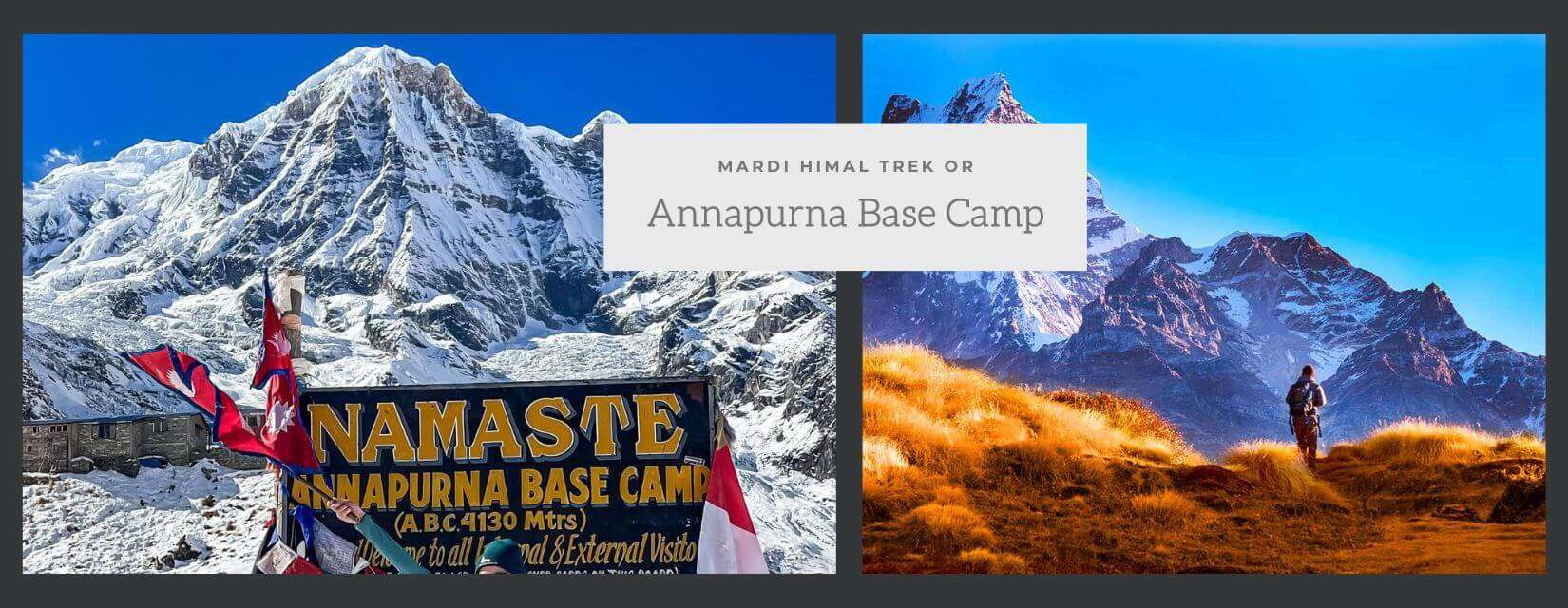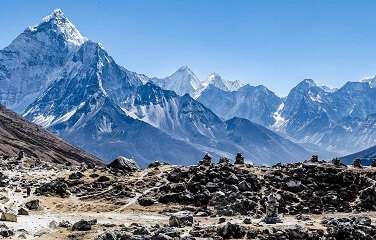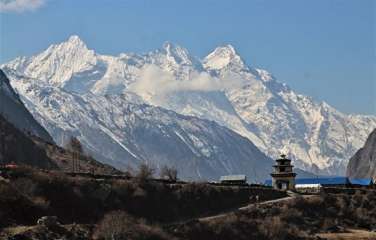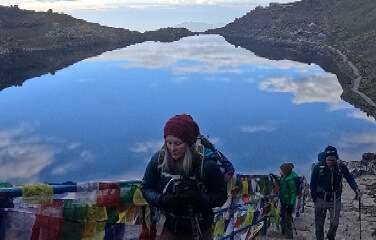Scenery and Landscape

Mardi Himal Trek:
This trek is a hidden gem, offering a more remote and less crowded experience. It takes you through dense rhododendron forests, up to the Mardi Himal Base Camp, where you'll be treated to close-up views of Machapuchare (Fishtail), Annapurna South, and Hiunchuli. The trail feels untouched compared to more popular treks, offering a serene and wild landscape, especially as you ascend to higher elevations.
Annapurna Base Camp Trek:
The ABC trek is famous for its diverse scenery. You'll trek through terraced fields, lush forests, traditional villages, and high alpine landscapes. The highlight is the final approach to Annapurna Base Camp, a natural amphitheater surrounded by towering peaks like Annapurna I, Machapuchare, and Gangapurna. This trek is more popular, which means you'll encounter more fellow trekkers and tea houses along the way.
Verdict:
- If you want solitude and an off-the-beaten-path experience, Mardi Himal is ideal.
- For a mix of diverse landscapes and the iconic Annapurna Sanctuary, ABC is your trek.
Difficulty and Altitude
Mardi Himal Trek:
The Mardi Himal trek is considered moderate in difficulty. The highest point is Mardi Himal Base Camp at 4,500 meters. The daily altitude gain is more gradual, and the trail isn’t too technical. However, it does have some steep sections, particularly when nearing High Camp and Base Camp.
Annapurna Base Camp Trek:
The ABC trek is also moderate in difficulty, with the highest point at Annapurna Base Camp (4,130 meters). The trail has a steady ascent but involves longer days of trekking, and the altitude can be challenging, particularly for those without proper acclimatization. However, it is a more established route, with well-maintained paths and tea houses throughout.
Verdict:
Both treks are of similar difficulty, though ABC has a slightly more consistent ascent, while Mardi Himal can feel steeper in parts. The Mardi Himal trek reaches a higher elevation, but ABC involves longer trekking days.
Crowds and Atmosphere

Mardi Himal Trek:
This is a relatively quiet trek compared to ABC. Because it's newer and less known, you’ll likely encounter fewer trekkers. The tea houses are more basic, and you’ll have a more intimate experience with the local culture and nature.
Annapurna Base Camp Trek:
The ABC trek is one of the most popular in Nepal so you can expect more crowds, especially during peak trekking seasons (October-November, March-April). While this can be a social experience for those who enjoy meeting fellow trekkers, it also means more commercialization.
Verdict:
For a quiet, less commercialized trek, go for Mardi Himal. If you don’t mind trekking with more people and want access to better infrastructure, choose ABC.
Trek Duration
Mardi Himal Trek:
The Mardi Himal Trek can be completed in 5-7 days, making it a shorter trek overall. It's a great option if you’re short on time but still want a rewarding Himalayan experience.
Annapurna Base Camp Trek:
The ABC trek typically takes 7-11 days depending on your starting point and acclimatization needs. It’s a longer trek, but the extra days allow you to experience more varied terrain and villages.
Verdict:
If you have limited time, Mardi Himal is a better fit. For a longer, more immersive trek, ABC is ideal.
Cultural Experience

Mardi Himal Trek:
While Mardi Himal is more remote, you’ll pass through small Gurung and Magar villages, offering a chance to engage with local communities. However, the cultural aspect is less prominent compared to the ABC trek.
Annapurna Base Camp Trek:
ABC takes you through several traditional villages, including Chhomrong, Ghandruk, and others, offering richer cultural immersion. You’ll have more opportunities to experience the local hospitality, visit traditional houses, and learn about the unique blend of Hindu and Buddhist traditions in this region.
Verdict:
For a more immersive cultural experience, ABC is a better choice. Mardi Himal offers culture but in a more understated way.
Cost and Accessibility
Mardi Himal Trek:
Mardi Himal is slightly less expensive because it’s shorter and less commercialized. Fewer trekkers mean lower accommodation costs, though the trek can still be reached easily from Pokhara.
Annapurna Base Camp Trek:
ABC is a more popular trek, which means prices for tea houses and food are a bit higher. However, due to the number of tea houses along the way, there’s more competition, so prices can be negotiated. ABC is also accessible from Pokhara, with multiple starting points like Nayapul or Jhinu Danda.
Verdict:
Mardi Himal tends to be slightly cheaper overall due to its shorter duration and fewer trekkers, while ABC offers more variety in accommodations and services.
Conclusion: Which Trek Should You Choose?
Choose Mardi Himal Trek if:
- You prefer a quieter, less crowded trek.
- You want to reach higher altitudes and have stunning close-up views of Machapuchare.
- You have limited time and want a shorter trekking experience.
Choose Annapurna Base Camp Trek if:
- You want a more immersive cultural experience with diverse landscapes.
- You’re okay with a more popular and social trek.
- You have more time and want a longer trek with well-established infrastructure.
Both treks are beautiful in their own right, so it ultimately comes down to your preferences for solitude, culture, and time.
Trek Highlights
Mardi Himal Trek:
- High Camp and Mardi Himal Base Camp: These spots offer some of the most striking and up-close views of Machapuchare, Mardi Himal, and the Annapurna range. The experience of being at Mardi Base Camp feels raw and isolated due to the trek’s lesser-known status.
- Rhododendron Forests: The lush, blooming forests, especially during spring, create a magical trekking experience.
- Less Commercialized: With fewer tea houses and simpler amenities, you get a more authentic Himalayan experience.
Annapurna Base Camp Trek:
- Annapurna Sanctuary: The crown jewel of this trek is undoubtedly arriving at Annapurna Base Camp, a natural amphitheater surrounded by some of the highest peaks in the world, including Annapurna I (8,091m), Machapuchare (6,993m), and Hiunchuli (6,441m).
- Hot Springs: One of the key highlights for many trekkers is the natural hot springs at Jhinu Danda. After days of trekking, relaxing in these hot springs is a welcome break.
- Gurung Villages: The trek takes you through charming Gurung villages such as Ghandruk and Chhomrong, offering insight into the local mountain culture and traditions.
Verdict:
Both treks have incredible highlights. Choose Mardi Himal if you want a more rugged, wild experience. Opt for ABC if you’re excited by cultural encounters and the grandeur of reaching Annapurna Base Camp.
Wildlife and Natural Beauty
Mardi Himal Trek:
The Mardi Himal region is rich in biodiversity. Trekking through the dense forests, you may spot various species of birds and animals like the Himalayan Monal, Danphe (Nepal's national bird), and even langur monkeys. The trail offers an incredible blend of forest, alpine meadows, and panoramic mountain views.
Annapurna Base Camp Trek:
The ABC trek also boasts rich biodiversity, but due to its popularity and higher human presence, you might see less wildlife along the trail. However, the diversity of flora is outstanding, particularly during spring when the rhododendrons bloom in vibrant shades of red, pink, and white.
Verdict:
For more untouched natural beauty and wildlife encounters, Mardi Himal may have the edge. ABC, while scenic, is more cultivated and developed, with fewer wildlife sightings.
Season and Weather

Both treks are ideal during the same trekking seasons:
- Autumn (October-November): The skies are clear, and the weather is stable. This is peak trekking season for both Mardi Himal and ABC.
- Spring (March-May): During this season, the rhododendron forests along both trails are in full bloom, adding to the natural beauty.
- Winter (December-February): While both treks can be done in winter, Mardi Himal is more likely to have snow at higher elevations, making the trek a bit more challenging. ABC can also experience snow, but the trail is more accessible due to its established infrastructure.
- Monsoon (June-September): Monsoon season brings heavy rain, leeches, and limited visibility on both treks, but Mardi Himal may feel more slippery and prone to landslides due to the less maintained trails.
Verdict:
Both treks are best undertaken in autumn and spring. If you plan to trek in winter, ABC may be more manageable, thanks to the better infrastructure.
Adventure Level and Remote Experience
Mardi Himal Trek:
Mardi Himal offers a more isolated and adventurous trek. The trail feels wilder, especially as you approach High Camp and Base Camp. The narrow ridges and higher, less-trafficked routes give a more adventurous vibe compared to the ABC trail.
Annapurna Base Camp Trek:
While ABC is still an adventure, the established routes and larger number of tea houses create a more predictable experience. For some, the familiarity of meeting more trekkers and having frequent rest stops is reassuring. For others, it may feel a bit too organized.
Verdict:
If you crave adventure and solitude, Mardi Himal will provide a more remote experience. If you want a structured trek with more creature comforts, ABC is a better option.
Trek Combinations
Mardi Himal Trek:
Mardi Himal can be combined with other trekking routes around the Annapurna region, such as the Ghorepani-Poon Hill trek or even a detour to Ghandruk. However, its stand-alone route is typically chosen by those looking for a shorter, less crowded option.
Annapurna Base Camp Trek:
ABC offers greater flexibility when it comes to trek combinations. Many trekkers combine ABC with the Ghorepani Poon Hill trek, which adds an extra 3-4 days but rewards you with panoramic views from Poon Hill. You can also include side trips to Hot Springs and villages like Ghandruk, making it a more diverse trek overall.
Verdict:
For greater variety and potential combinations with other iconic routes, ABC has more options. Mardi Himal can also be extended, but ABC offers more flexibility.
Final Thoughts
Mardi Himal Trek:
- Best for those seeking an off-the-beaten path, quieter, and shorter trek.
- Perfect for solitude lovers and trekkers who enjoy less crowded trails and a raw mountain experience.
- Ideal if you want a close-up view of Machapuchare and a high-altitude adventure without committing to a long trek.
Annapurna Base Camp Trek:
- A better choice for trekkers looking for a culturally rich, longer trek with varied landscapes.
- Suitable for those who prefer well-developed trails, more social interactions with fellow trekkers, and an immersive experience of local village life.
- Ideal if reaching the iconic Annapurna Base Camp is your ultimate goal.
Both treks offer something unique, and whichever you choose, you’ll be rewarded with unforgettable views of the Annapurna region and memories of a lifetime.





